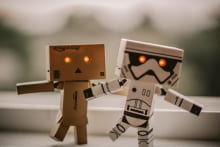By: Keaton Fletcher
What kind of robot would you want for a teammate? A recent theoretical paper argued that robot personality will influence individuals’ and teams’ motivation. To better understand robot personality, we must first briefly describe personality traits in humans. The most widely accepted model of human personality captures an individual’s general tendencies and preferences within five primary domains: extraversion (i.e., outgoingness and social dominance), neuroticism (i.e., emotional volatility, anxiety), agreeableness (i.e., politeness and preference for social harmony), conscientiousness (i.e., orderliness, detail-oriented, rule-abiding), and openness to experience (i.e., willingness to experience novel and ambiguous situations or stimuli). Generally speaking, we value high levels of extraversion, agreeableness, conscientiousness, and openness to experience, and low levels of neuroticism.
As robots become more advanced, humanoid, and ubiquitous, an understanding of robot personality in teams should help roboticists design and program the ideal robot teammate. Robert Jr. argued that, just like humans, a robot that appears to be high in all of the Big Five personality traits except for neuroticism, would help keep individuals and teams motivated. A study from 2006 found that simply being humanoid (as opposed to more mechanical) in shape, led to robots being perceived as higher in the Big Five (lower in neuroticism). If Robert Jr.’s theory is supported, this would suggest that when creating teams that incorporate robots, it is better to have a humanoid shaped robot than other designs, because this may help teams and individuals set more challenging goals, work harder and longer to achieve these goals, have a stronger belief that they can achieve these goals, which should ultimately improve performance and satisfaction. That said, as artificial intelligence capabilities increase, there may be ways to program the apparent personalities of robots to be more tailored to the situation, like what is seen in the 2014 movie Interstellar, or, less effectively, in the book series, Hitchhiker’s Guide to the Galaxy.

